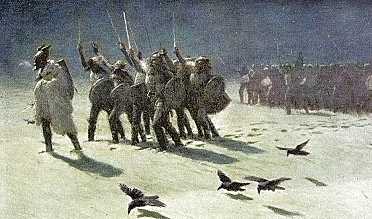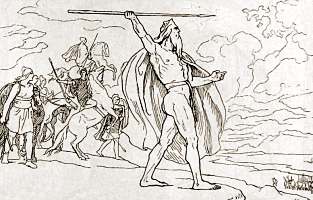
|

|
The First War
Ásgarð is the home of the Æsir, the race of the gods and goddesses of war, such as Óðin and Þór. On the same level of the world lies Vanaheim, home of the Vanir, the fertility gods and goddesses, such as Freyr and Freyja.
In the "golden era" of the distant past, the gods lived in harmony, playing games in the meadows. One day, Gullveig visited Óðin in his hall at Ásgarð. Gullveig could talk of nothing but her love for gold. The Æsir loathed listening to such talk, and decided that the world would be better off without her. They seized her, riddled her body with spears, and threw her onto the fire in the center of the hall. She burned to death, but stepped whole out of the flames. Twice more, she was seized, killed, and burned. Twice more, she walked whole out of the flames. She was a seer and enchantress, the mistress of evil magic.
 When
the Vanir heard how the Æsir had welcomed Gullveig,
they swore vengeance and began to prepare for war. Óðin,
sitting in his high seat in Valaskjálf, saw the preparations,
and soon the Æsir, too, prepared for war.
When
the Vanir heard how the Æsir had welcomed Gullveig,
they swore vengeance and began to prepare for war. Óðin,
sitting in his high seat in Valaskjálf, saw the preparations,
and soon the Æsir, too, prepared for war.
 The gods moved against each other. Óðin cast his spear
into the host of the Vanir. Thus, the first war began.
The gods moved against each other. Óðin cast his spear
into the host of the Vanir. Thus, the first war began.
The Vanir quickly gained the upper hand. Using magic, they reduced the walls of Ásgarð to rubble. The Æsir moved forward, and caused similar damage to Vanaheim. The battle raged, and the longer it went on, the more clear it became that neither side was likely to win.
The gods wearied and decided to meet to discuss terms. They argued about the origin of the war, and whether the Æsir alone were responsible, or whether both sides were entitled to tribute. In the end, they decided to live together in peace. To enforce this agreement, leaders from the two sides were exchanged as hostages.
Njorð, his son Freyr, and his daughter Freyja, who were the leading Vanir, traveled to Ásgarð. In exchange, the Æsir sent Hœnir and Mímir to Vanaheim.
The Vanir appointed Hœnir to be one of their leaders. With the wise Mímir at his side, Hœnir was unfailing. But without Mímir, Hœnir seemed incapable of making a decision. "Let someone else decide," he would always say.
The Vanir suspected that they had been tricked, and that they had gotten the worse part of the bargain in the exchange of leaders. For revenge, they hacked off the head of Mímir and sent it by messenger back to Óðin and the Æsir.
Óðin cradled the head, smearing it with herbs and chanting magical charms over it. The head was preserved from decay and given the power of speech, so that Mímir could always share his wisdom with Óðin.
Freyja taught Óðin the magic called seiðr,
which carried great power. He could learn men's fates, see the
future, bring death and misery, or transfer intellect and strength
from one man to another. But this magic was so unseemly and effeminate
that it was thought shameful for men to have anything to do with
it.
|
Clearly, much of this story is missing. Some historians claim that it recalls a time in Norse prehistory (perhaps 2nd millennium BC) when two cults struggled for dominance in Scandinavia. One group prevailed (the northward moving Indo-Germanic battle axe people), and the two cults ultimately fused. Traditionally, battles in the Norse era began with a spear being cast into the opposing army, in honor of the spear cast by Óðin in the first war. This spear-cast dooms the enemy to defeat and death. With the first war, the golden age of the Norse gods was over. Neither side could defeat the other, so they chose to form a union. The unfailing killing power of Óðin was united with the unfailing regenerative power of Freyja. |
|
|
©1999-2025 William R. Short |